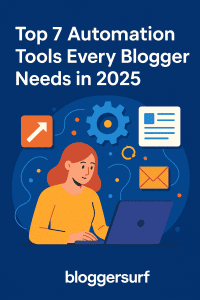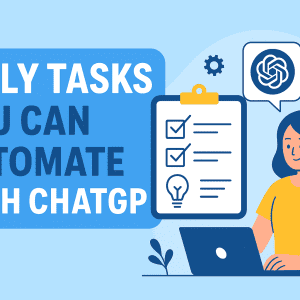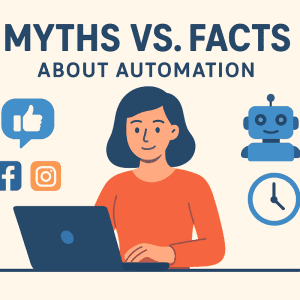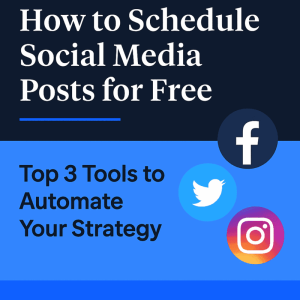Discover the top 7 blog automation tools for 2025 that can save you time, boost productivity, and help your blog grow faster. Perfect for Bloggersurf readers!
Contents
Introduction
In 2025, the blogging world is moving faster than ever. Between managing content, promoting posts, responding to comments, and analyzing traffic, bloggers can easily feel overwhelmed. That’s where automation tools come in.
With the right automation tools, you can:
- Save hours every week.
- Grow your audience faster.
- Keep your blog running even when you’re away.
In this post, we’ll explore 7 powerful blog automation tools every blogger should use in 2025 to stay ahead of the game.
1. Buffer – Social Media Scheduling
Why Bloggers Love It:
Social media is essential for driving traffic, but posting manually takes time. Buffer lets you schedule posts for Facebook, Instagram, Twitter, LinkedIn, and more — all in one place.
Key Features:
- Drag-and-drop calendar
- AI post suggestions
- Detailed analytics
Automation Tip:
Set up Buffer to automatically share your new blog posts to all your social platforms the moment they’re published.
2. Jasper AI – Content Writing Assistant
Why Bloggers Love It:
Writer’s block? No problem. Jasper AI uses advanced AI to help you create blog content, ad copy, social captions, and even email newsletters.
Key Features:
- Dozens of AI templates
- Long-form assistant for blog posts
- SEO-optimized output
Automation Tip:
Use Jasper to create blog post outlines and introductions automatically, then refine them with your own voice for a personal touch.
3. ConvertKit – Email Marketing Automation
Why Bloggers Love It:
Email is still one of the most effective ways to engage readers. ConvertKit lets you set up automated welcome sequences, product launches, and weekly newsletters without lifting a finger.
Key Features:
- Visual automation builder
- Subscriber tagging
- A/B testing
Automation Tip:
Create a welcome email series that introduces your blog, offers your best posts, and encourages readers to follow you on social media.

1. Leveraging AI for Content Personalization
Automation isn’t just about posting at the right time—it’s about sending the right message to the right person.
With AI-driven audience segmentation, you can:
- Identify reader personas based on past engagement.
- Deliver tailored headlines and featured images for different reader groups.
- Use dynamic content blocks that change based on the reader’s location or browsing history.
Example Workflow:
- Use Google Analytics + automation platforms like ActiveCampaign.
- Segment your audience into categories like New Visitors, Returning Readers, and Subscribers.
- Create automated content recommendations for each group.
SEO Tip: Add LSI keywords like “AI content recommendations” and “personalized blogging automation” to rank higher for related searches.
2. Multi-Platform Content Repurposing
Why create 10 different pieces of content when you can create one master article and turn it into multiple formats?
Automation tools can instantly transform your blog post into:
- A short-form LinkedIn article
- A carousel post for Instagram
- A narrated video for YouTube Shorts
- A podcast-style audio file
Tools You Can Use:
- Repurpose.io – auto-distribute your content in multiple formats.
- Canva’s Magic Resize – one design, multiple platform sizes.
- Descript – auto-generate videos and audio transcripts.
Pro Automation Flow:
Blog post → AI Summary → Canva Templates → Auto-scheduling via Buffer or Publer.
3. Social Media Drip Campaigns
Instead of posting once and forgetting, drip campaigns keep your audience engaged over weeks or even months.
How it Works:
- Break one blog post into 8–10 short tips.
- Schedule them across Twitter, LinkedIn, and Facebook using Zapier or Metricool.
- Add a soft CTA in every post linking back to your main article.
CTA Example: “Want the full guide? Read the complete post here: Bloggersurf.com/automation-guide”
4. Automated Email Sequences
Email marketing remains one of the highest ROI channels, and with automation, it becomes a hands-free audience nurturer.
Steps:
- Create a lead magnet—like a free PDF, checklist, or webinar.
- Use tools like MailerLite or ConvertKit to auto-send:
- Welcome email
- Day 2: Related blog post
- Day 5: Exclusive tips
- Day 7: CTA to subscribe or purchase
Bonus Tip: Add automated link tagging so you can track which email leads to the most clicks.
5. Monitoring & Optimization on Autopilot
Automation without tracking is like driving with your eyes closed. Set up systems to analyze and adjust automatically.
- Google Data Studio Dashboards – updated automatically.
- Hotjar Heatmaps – see where users click most.
- A/B Testing Tools – auto-switch between versions to find the best-performing layout.
Example Automation Flow:
Post → Track → AI Report → Adjust content & repost.
6. Monetization Automations
Even your blog’s income streams can be automated.
- Affiliate Link Rotation – Tools like ThirstyAffiliates automatically replace outdated links with new offers.
- Ad Network Auto-Optimization – Platforms like Ezoic adjust ad placements in real-time for maximum RPM.
- Subscription Billing – Set-and-forget payment systems with Stripe or Paddle.
Conclusion: Automation is the Blogger’s Best Friend
The smartest bloggers aren’t the ones working the hardest—they’re the ones who’ve set up self-sustaining systems. By combining AI tools, workflow automations, and constant optimization, your Bloggersurf audience can grow 24/7 without your constant presence.
📌 Call to Action
If you’re ready to turn your blog into an automated traffic machine, subscribe to Bloggersurf for exclusive automation guides, free resources, and tool recommendations. 🚀
👉 Click Here to Join Now





Pingback: History of Automation: From Industrial Revolution to AI » Blogger Surf
Pingback: Top 5 Free Tools to Automate Daily Online Tasks » Blogger Surf